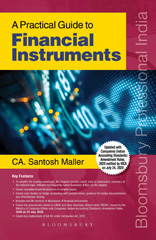Practical Guide to Financial Instruments
800 p.
About the book Accounting for financial instruments under Ind AS is generally complex. In India, we do not have much of a history of a comprehensive and robust accounting framework for financial instruments. Historically, accounting for financial instruments is primarily based on form rather than the contractual terms of instruments. Focus on accounting for financial instruments started only since 2007. Owing to global financial crisis which raised issues regarding accounting treatment of financial instruments, various accounting standards setting bodies examined the robustness of accounting for financial instruments. Further, Ind AS transition resulted in high-quality, principles-based, globally comparable financial reporting of large Indian companies. Accounting for financial instruments under Ind AS is quite robust and comprehensive. Towards this end, this book attempts to provide insights and in-depth analysis on interpretative issues and complex principles in the Ind ASs dealing with financial instrument
s. The requirements of Ind AS 32, Financial instruments: Presentation, Ind AS 109, Financial instruments, and Ind AS 107 Financial instruments: Disclosures are extensively dealt with. There are separate chapters addressing: Scope of the requirements. Debt/equity classification. Classification. Recognition and Derecognition. Subsequent measurement. Fair values and impairment. Hedge accounting. Presentation and Disclosures. Implications on key provisions of Companies Act, 2013. ICAI's Guidance Note on Accounting for Derivative Contracts. This book is intended to help the companies to identify Ind AS requirements that are relevant to them and evaluate various aspects of financial instruments accounting. The book would be an immensely useful referencer for professionals, practitioners and corporates. Key features - To simplify the reading experience, the chapters include a brief, easy to understand, summary of the relevant topic, followed by Frequently Asked Questions (FAQs) on the chapter. - Covers examples-base
d illustrations of complex topics. - Covers case studies on hedge accounting with journal entries, guidance for hedge documentation and effectiveness testing. - Includes real life extracts of disclosures of financial instruments. - Covers the amendment related to LIBOR and other interbank offered rates ('IBORs') issued by the Ministry of Corporate Affairs vide Companies (Indian Accounting Standards) Amendment Rules, 2020 on 24 July, 2020. - Covers key implications of Ind AS under Companies Act, 2013.About the book. [Publisher's text].
Special access authorizations may apply; please contact us for further information.
-
Información
ISBN: 9789390176397
MATERIAS


